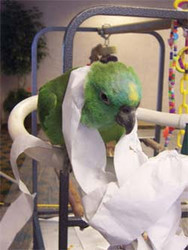How To Get Your Parrot To Play With Toys
Posted by Parrot Toys, Parrot Training, Parrot Behaviour, Parrot Play on 10/4/2025
Here is how to get your Parrot to play with toys.
New toys
I have been inspired by a question posted to my yahoo group. The question was asked how do you get a Parrot used to a new toy? I think that is a marvellous question.
All too often we assume because it is a toy, our Parrots should automatically be eagerly interacting with it. In general Parrots tend to show hesitancy around new items or situations. As positive reinforcement enthusiasts, most of us know that we can train our birds to be calm and confident with change. But it does take some investment on our part.
Not a financial investment, but a commitment to teaching your bird via positive reinforcement training strategies. But if in this moment your bird has clearly demonstrated new Parrot toys create a fear response, what can you do?
Technique
I usually start with systematic desensitization. This means I place the toy a distance away from the Parrot. I also make sure the bird is presenting calm relaxed body language. I then leave the toy there for a period of time, maybe even days.
Over time I gradually place the toy closer and closer to the cage. Again making sure the Parrot is relaxed and comfortable. Eventually I may hang the toy on the outside of the cage, but near the bottom of the cage. I can gradually move it higher.
When the Parrot is ready, I can try moving the toy to inside the cage. I usually put it away from food and water bowls and preferred perches. This is because if the bird has any concerns with the toy that I failed to notice, it will not be a hindrance to his physical needs and comfort.
Once the Parrot is comfortable with the toy in his cage, now I can consider some of my other positive reinforcement tools of the trade. I can use a target to help encourage the Parrot to move closer to the toy. I could pair positive reinforcers with the toy, by placing them near or on the toy.
Free shape
I could also ?free shape? the behaviour.
To free shape, rather than use a target or a food prompt, I would just wait until the bird presents an approximation I can reinforce. For example if the bird looks at the toy I can reinforce that.
After several repetitions the bird may move in the direction he has been looking. I can reinforce that. Eventually the Parrot may move closer, and over time try to touch the toy. This is all shaped by looking for the slightest approximation towards the desired goal behaviour of interacting with the toy.
I recently used this strategy to help my puppy get past a fear response he had with a new vacuum cleaner. First I reinforced him for looking at the vacuum from far away and then reinforced him for approximations he took moving closer to the thing.
He then sniffed it and eventually touched it with his nose and paws, and even moved it.
The entire process took about twenty minutes. I have promised my yahoo group I would get the video clip on my You Tube site.https://www.youtube.com/GoodBirdInc
I will notify everyone once it is up!
Hope this gives readers some ideas for ways to get your Parrot playing! Find lots of fun toys for your Parrot here.
Contact details
This article was originally published on Good Bird?s blog in April 2008.
Barbara Heidenreich
Barbara Heidenreich has been a professional animal trainer since 1990. Her company Barbara?s Force Free Animal Training (www.BarbarasFFAT.com) provides animal training DVDs, books, webinars and workshops. She has been a featured speaker in over twenty countries and has been published in nine languages. Barbara works with the companion animal community and also consults on animal training in zoos.




